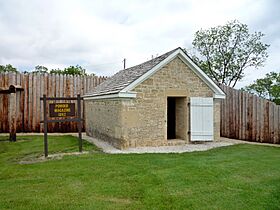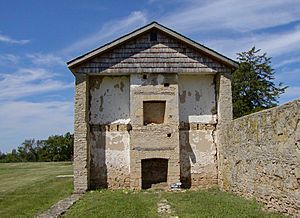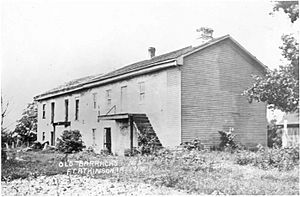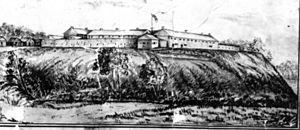Fort Atkinson State Preserve facts for kids
Quick facts for kids Fort Atkinson State Preserve |
|
|---|---|

Fort Atkinson's powder magazine
|
|
| Lua error in Module:Location_map at line 420: attempt to index field 'wikibase' (a nil value). | |
| Location | Winneshiek County, Iowa, United States |
| Area | 5 acres (2.0 ha) |
| Elevation | 1,096 ft (334 m) |
| Established | 1921 (state acquisition); 1968 (dedication) |
| Administered by | Iowa Department of Natural Resources |
|
Fort Atkinson Historic District
|
|
| NRHP reference No. | 13000036 |
| Added to NRHP | February 27, 2013 |
Fort Atkinson State Preserve is a special place in Winneshiek County, Iowa. It holds the remains of an old U.S. Army fort. This fort was built a long time ago to help keep peace. It aimed to stop different Native American tribes from fighting. It also kept white settlers from moving onto Native lands. In 2013, Fort Atkinson was added to the National Register of Historic Places. This means it is a very important historical site.
Contents
The Fort's Story: Why it was Built
The story of Fort Atkinson starts with a treaty in 1830. This agreement created a "Neutral Ground." It was a strip of land about 40 miles wide. This land was meant to be a safe space between tribes. Later, the Ho-Chunk (or Winnebago) tribe moved there. They had been moved from Wisconsin.
Fort Atkinson was built to help the Ho-Chunk tribe. Soldiers made sure they stayed on the Neutral Ground. They also protected the Ho-Chunk from other tribes. The fort stopped white traders and settlers from entering Native lands. It also supported a U.S. government official. This official ran a school and a farm for the Ho-Chunk.
Building the Fort: Soldiers and Construction
A camp was set up on May 31, 1840. Captain Lynde and his soldiers started the fort. It was named after Henry Atkinson. He was in charge of moving the Ho-Chunk people. The fort took three years to build. It was finished by the end of 1842.
Many different army groups served at the fort. The 1st US Dragoons and 1st US Infantry were among them. In August 1842, 196 soldiers were stationed there. This was the largest number of troops at the fort. Some soldiers left to fight in the Mexican–American War in 1846.
After the Army: A New Purpose
After the regular army left, local volunteers took over. They helped move the Ho-Chunk from Iowa to Minnesota in 1848. The last volunteers left in September 1848. The fort was empty for a short time. Then, the 6th US Infantry arrived from Mexico. They stayed until February 1849, when the fort was finally abandoned.
The fort was sold to private owners in 1855. They planned to build a town there. In 1921, the state of Iowa bought the fort. Reconstruction work began in 1958. In 1968, Fort Atkinson became a State Preserve. It is valued for its history, geology, and archaeology. The stone used to build the fort is called Fort Atkinson Limestone. It formed from a shallow tropical sea about 440 million years ago.
Fort Design: What it Looked Like
Fort Atkinson was built like many frontier forts. It had a rectangular shape. A tall wooden fence, called a stockade, surrounded it. Inside, there were 24 buildings. Outside the stockade, there were 14 more buildings.
In the middle of the fort was a parade ground. Four main barracks (where soldiers lived) surrounded it. There were also special buildings for defense. Cannon houses were at two corners. A gunpowder magazine (for storing gunpowder) was in another corner. A commissary (for food and supplies) was in the last corner. Buildings outside included a granary, bakery, blacksmith shop, and stables. The buildings were made from limestone rock found nearby. Some were made from hewn logs. All had roofs made of cut-pine shingles.




